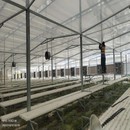The airtightness of the film is strong, so after the shed is covered, the evaporation of soil moisture and crop transpiration in the shed will cause the high temperature of the air in the shed. Without ventilation, the relative humidity in the shed will be very high. When the shed temperature increases, the relative humidity decreases, and the shed temperature decreases and the relative humidity increases. On sunny and windy days, the relative temperature is low, and on cloudy and rainy (foggy) days, the relative temperature increases. In the absence of ventilation, the relative humidity in the shed can reach 60-80% during the day, and is often around 90% at night, up to 100%. The appropriate relative humidity of the air in the shed varies according to the types of crops. Generally, it should be maintained at 50-60% during the day and 80-90% at night. In order to reduce the harm of diseases, the humidity at night should be controlled at about 80%. When the relative humidity in the shed reaches saturation, increasing the shed temperature can reduce the humidity. For example, when the humidity is at 5℃, every 1℃ increase in air temperature will reduce the humidity by about 5%. When the temperature is at 10℃, every 1℃ increase in air temperature will reduce the humidity. Reduce by 3-4%. Without increasing the moisture content in the air in the shed, when the shed temperature is 15°C, the relative humidity is about 7%; when it is increased to 20°C, the relative humidity is about 50%. Because the air temperature in the shed is high and the soil evaporation is small, the irrigation volume should be reduced in the winter and spring seasons. However, the increase in temperature in the greenhouse or the need for ventilation when the temperature is too high will cause the humidity to drop, accelerate the transpiration of crops, reduce the transpiration rate of plants in water shortage, or cause physiological disorders.










